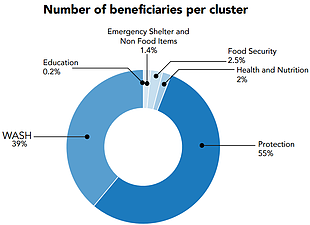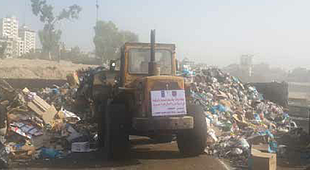Overview of Emergency Response Fund (ERF) and Central Emergency Fund (CERF)
Over US$16 million mobilised to support urgent needs in Gaza
 Given the scale of the emerging crisis triggered by the July-August hostilities, it was critical to ensure that much needed resources would be on the ground as fast as possible. To ensure this, in addition to the regular funding to humanitarian agencies and the special funding obtained via the Gaza Crisis Appeal, the Humanitarian Country Team (HCT) mobilised over US$16 million from two pooled funds: the CERF, which is managed by a secretariat in New York on behalf of the Emergency Response Coordinator, and the ERF, which is managed in-country by the Humanitarian Coordinator with the support of OCHA and a technical review board of humanitarian partners and an advisory board of donors.
Given the scale of the emerging crisis triggered by the July-August hostilities, it was critical to ensure that much needed resources would be on the ground as fast as possible. To ensure this, in addition to the regular funding to humanitarian agencies and the special funding obtained via the Gaza Crisis Appeal, the Humanitarian Country Team (HCT) mobilised over US$16 million from two pooled funds: the CERF, which is managed by a secretariat in New York on behalf of the Emergency Response Coordinator, and the ERF, which is managed in-country by the Humanitarian Coordinator with the support of OCHA and a technical review board of humanitarian partners and an advisory board of donors.
Emergency Response Fund
The ERF started processing project applications in close coordination with the clusters from the frst week of the emergency. From 8 July until the end of September, the ERF received a total of 65 proposals to respond to the Gaza emergency, of which 28 proposals have been approved to address critical needs in the following areas:
- WASH (potable water);
- Food Security (supporting emergency food distribution for IDPs hosted in non UNRWA schools);
- Education (emergency repairs to damaged schools and kindergartens);
- Protection (psycho-social response, GBV and UXO clearance);
- Health and Emergency Shelter and Non-Food Items (NFI).
In total, US$6.25 million worth of projects have been approved. The frst ERF funded project started on 22 July to distribute NFIs to the IDPs hosted in collective shelters and was implemented by an international NGO. Shortly after, UNMAS managed to get the first team on the ground as a result of ERF resources.
ERF case study
Action Contre La Faim (ACF) used the ERF to support 1000 families (7,200 persons) facing severe water shortages in the southern Gaza Strip. ACF distributed 1,000 water storage tanks (250 litres, one per family). Beneficiary families received 30 vouchers per month: each voucher is worth 250 litres of drinking water. ACF received a total of US$129,919.40 to implement the project between July and October 2014
Central Emergency Response Fund
In parallel with efforts to engage the ERF mechanism, the HCT also mobilized the CERF to kick-start funding for larger-scale critical projects by UN agencies and their partners. The MIRA assessment was not conducted prior to applying to the CERF, given the dangerous security situation and access challenges. However, the HCT, supported by analysis from the Emergency Operations Centre in Gaza, established the priority areas for humanitarian assistance as the provision of basic services including water, health, energy and solid waste collection, food assistance, psychosocial support and adequate management of shelters.[1]
Based on this analysis, the HCT identified the agencies best placed to respond in these areas. A package of six projects was submitted to the CERF by the HCT on behalf of WHO, UNRWA, UNICEF, UNDP, WFP and OHCHR. Altogether, US$10.8 million was mobilized to allow these six UN agencies and their implementing partners to start deliveries of emergency food, legal assistance, lifesaving medication, solid waste management, psychosocial support, emergency water and sanitation network repair and water tanks to those most affected in Gaza, including the internally displaced.
Removal of solid waste
 One of the projects to be implemented as a result of CERF support is an intervention by UNDP to remove the dangerous levels of solid waste that had accumulated in streets, residential buildings and overflowing dumpsters during the almost two months of hostilities. Once it is completed, the project should benefit one million Gaza residents. Municipal service providers, already weakened, were unable to carry out primary collection and transfer of waste to landfill sites. Obtaining funds on the ground quickly became increasingly urgent as communities living around sites of accumulated waste began to burn refuse, causing hazardous smoke to spread to surrounding areas, particularly in Khan Yunis and Beit Lahia. CERF funding allowed UNDP to carry out the safe and rapid removal of solid waste in priority areas in the north and south of the Gaza Strip, and helped to avert a potential public health disaster. Burned solid waste was also cleared. While CERF funding will allow clearance of waste from the most critical areas for a four month period, UNDP hopes that, with additional funding from other sources, the project will be able to continue once the CERF implementation period has expired and will include support to municipalities in primary collection and the provision of equipment.
One of the projects to be implemented as a result of CERF support is an intervention by UNDP to remove the dangerous levels of solid waste that had accumulated in streets, residential buildings and overflowing dumpsters during the almost two months of hostilities. Once it is completed, the project should benefit one million Gaza residents. Municipal service providers, already weakened, were unable to carry out primary collection and transfer of waste to landfill sites. Obtaining funds on the ground quickly became increasingly urgent as communities living around sites of accumulated waste began to burn refuse, causing hazardous smoke to spread to surrounding areas, particularly in Khan Yunis and Beit Lahia. CERF funding allowed UNDP to carry out the safe and rapid removal of solid waste in priority areas in the north and south of the Gaza Strip, and helped to avert a potential public health disaster. Burned solid waste was also cleared. While CERF funding will allow clearance of waste from the most critical areas for a four month period, UNDP hopes that, with additional funding from other sources, the project will be able to continue once the CERF implementation period has expired and will include support to municipalities in primary collection and the provision of equipment.
[1] During the 51 days of hostilities, Israeli forces conducted over 5,000 airstrikes, resulting in the use of over 8,210 missiles, 15,736 naval projectiles and 36,718 land projectiles. Armed groups in Gaza fred approximately 4,600 rockets and 1,700 mortars at Israel, some of which fell short and landed within Gaza.









